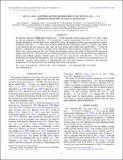SD 1313–0019: ANOTHER SECOND-GENERATION STAR WITH [Fe/H] = −5.0, OBSERVED WITH THE MAGELLAN TELESCOPE
Author(s)
Chiti, Anirudh; Placco, Vinicius M.; Frebel, Anna L.; Ji, Alexander Pung; Jacobson, Heather
DownloadFrebel-2015-SD 1313-0019_ ANOTHE.pdf (406.8Kb)
PUBLISHER_POLICY
Publisher Policy
Article is made available in accordance with the publisher's policy and may be subject to US copyright law. Please refer to the publisher's site for terms of use.
Terms of use
Metadata
Show full item recordAbstract
We present a Magellan/MIKE high-resolution (R ~ 35,000) spectrum of the ancient star SD 1313−0019, which has an iron abundance of [Fe/H] = -5.0, paired with a carbon enhancement of [C/Fe] ~ 3.0. The star was initially identified by Allende Prieto et al. in the BOSS survey. Its medium-resolution spectrum suggested a higher metallicity of [Fe/H] = -4.3 due to the Ca ii K line blending with a CH feature, which is a common issue related to the search for the most iron-poor stars. This star joins several other similar stars with [Fe/H] ≲ -5.0 that all display a combination of low-iron and high-carbon abundances. Other elemental abundances of SD 1313−0019 follow that of more metal-rich halo stars. Fitting the abundance pattern with yields of Population III supernovae suggests that SD 1313−0019 had only one massive progenitor star with 20-30 M[subscript ʘ] that must have undergone a mixing and fallback episode. Overall, there are now five stars known with [Fe/H] ≲ -5.0 (1D local thermodynamic equilibrium abundances). This ever-increasing population of carbon-rich, iron-deficient stars can potentially constrain nucleosynthesis in Population III stars and their supernova explosions, the formation mechanisms of the first low-mass stars, and the nature of the first galaxies.
Date issued
2015-09Department
Massachusetts Institute of Technology. Department of Physics; MIT Kavli Institute for Astrophysics and Space ResearchJournal
The Astrophysical Journal. Letters
Publisher
IOP Publishing
Citation
Frebel, Anna, Anirudh Chiti, Alexander P. Ji, Heather R. Jacobson, and Vinicius M. Placco. “SD 1313–0019: ANOTHER SECOND-GENERATION STAR WITH [Fe/H] = −5.0, OBSERVED WITH THE MAGELLAN TELESCOPE.” The Astrophysical Journal 810, no. 2 (September 9, 2015): L27. © 2015 The American Astronomical Society
Version: Final published version
ISSN
2041-8213
2041-8205